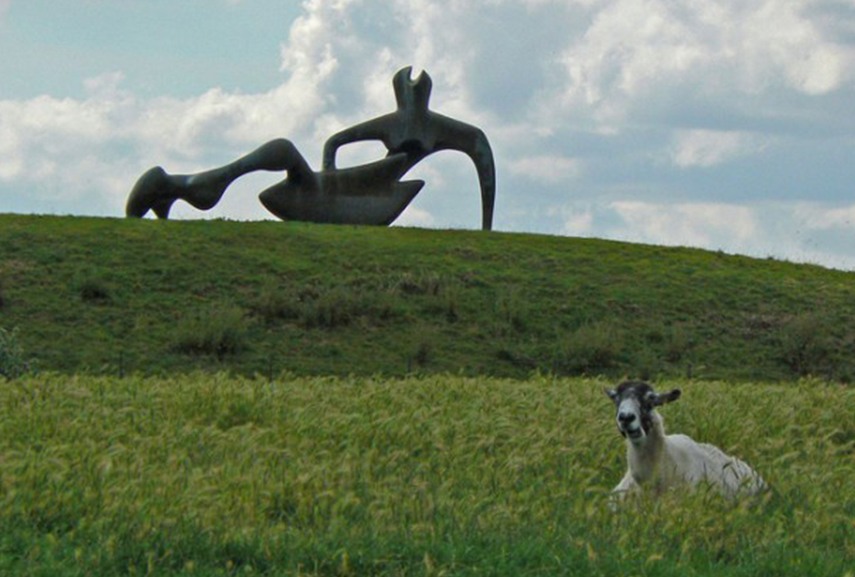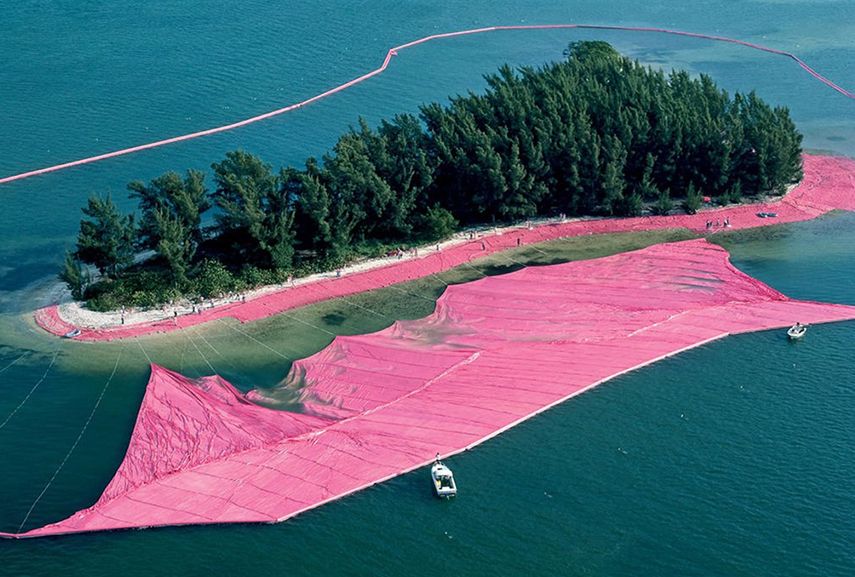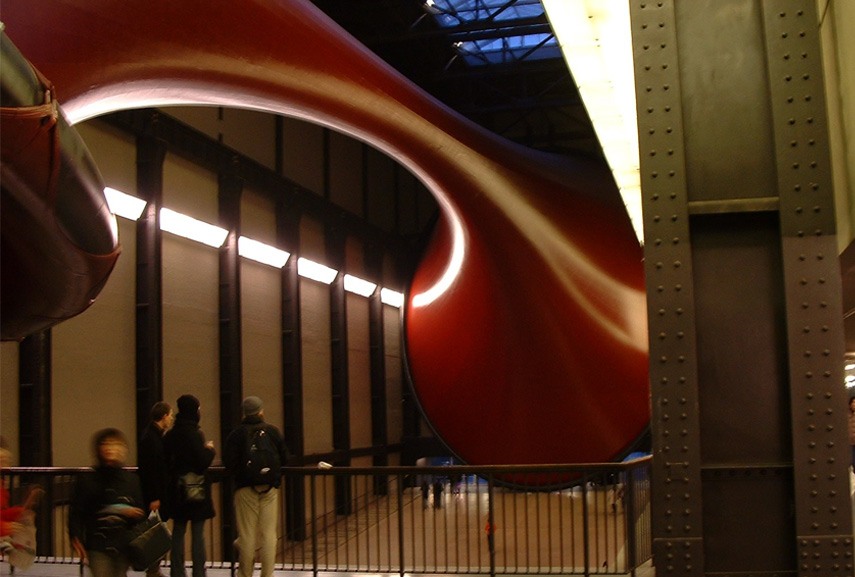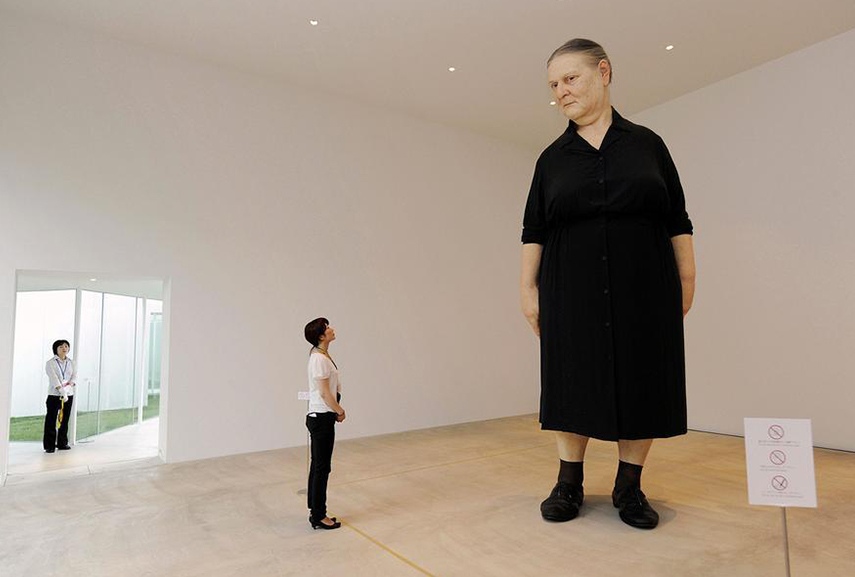What Is Anything Longer Than It Is Wide in Art
Altering one single property oftentimes changes everything. This is something most of us know is truthful, regardless of our occupation or lifestyle - a single typo makes the algorithm go wrong, replacing ane ingredient makes a different type of cake - changing one variable makes a whole new equation. It makes sense, then, to besides talk about oversized art as one of those peculiarities that get from familiar to strange in a glance. When everything seems to exist just the way we know it, only in an unnatural calibration, the event on our perception might be more powerful than whatever other. Large-scale art, especially the representational kind, evokes the uncanny in the spectator, much like Freud described it in his essay Das Unheimliche. It makes us experience drawn by the familiarity, simply likewise perplexed by the unknown, all contained in a unmarried epitome.[1]

Large Statues, Big Heroes
Fine art is a perfect tool to claiming and test human perception. Investing in large-scale sculptures or monumental buildings has always been a skillful manner to practice power, to amaze, or sometimes but to inspire. Big has been seen as equal to mighty. Statues and sculptures in Aboriginal Greece and Rome were thus made to be larger than life, nigh of them representing mythical beings, heroes or Gods. Some of them belong to the list of 7 Wonders of the Ancient Globe, such as Phidias' statue of Zeus or the Colossus of Rhodes. Architecture was no exception, having the pyramids and the ancient temples in mind. Information technology appears that, quite literally, physical greatness has always signified keen importance. During the Renaissance this pattern was repeated all over again - the difference in scale, according to which an ordinary human is apparenty smaller than Michelangelo'due south David, aims to represent the protagonist in a dominant style.

Large Scale Never Went Out of Manner
In the 20th century, people'southward view of the world was practically turned inside out, which was particularly vividly embodied in the arts. The notion of an artwork's concrete presence has changed, challenged by new ways of representation. In 1947, even the very thought that large equals powerful was problematized by Mies van der Rohe's statement that "less is more than", fifty-fifty if information technology did not straight apply to size but rather to abundance. Notwithstanding, art that is physically large never actually went out of fashion, even if information technology did change form. Master sculptors from the last century, such equally Henry Moore and Alexander Calder, introduced abstract sculptures that were large and massive, even if they lost their figurative grapheme. Oversized imagery had a big come up-back during the Pop Art era as well, and finally fifty-fifty today, deliberately large, close-up portraits seem to be a trend when it comes to visual arts. How can information technology be, that the i affair that hasn't change since artifact is the overwhelming power of the large calibration?
The actual presence of an artifact, be information technology a slice of jewelry or a edifice, is what gives u.s.a. that satisfying feeling of knowing it. We tin actually tell how much space it takes up, and whether it is something we tin hold in our hand or something we tin inhabit. Fifty-fifty today, when the significance of matter has been brought into question and somewhat overarched by technology, we cannot underestimate physical presence that still works with our instincts. Our senses react faster than our mind, informing u.s.a. that something is bigger than us, stronger, greater. However, while we let ourselves to be afflicted by appearances, our cognitive office works with the pregnant of that which we see. Because of that, the meaning of an oversized piece can go every bit many different things as we deem possible.

Oversized Object in Pop Art
This brings u.s. dorsum to oversized objects in Pop Art. One of its pioneers, Claes Oldenburg, became widely known for his three soft big-scale sculptures that became very pop over time. Flooring Burger, Flooring Cone and Flooring Cake were all fabricated with help from Oldenburg's wife, Patty Mucha, as part of an installation in 1962. Each represented exactly what their titles suggested. Playing with the dual nature of consumerism was one of the movement's main agendas. Thus, oversized blimp sculptures of junk food were irresistibly touchable, but like their existent-life prototypes are addictive and tasty. The spectator is now face up to face with a re-appropriated giant version of a meal that comes both equally a joke and true statement, precisely because of its size. You cannot ignore it and you'd really like to touch it, simply you tin definitely not swallow it. In favor of Pop Art where everything gets turned into a cartoon version of itself, the burger is yet another double agent - both disquisitional and laudatory of consumerist culture.

Sculptures in Terrain
Of course, there are different ways to exist 'big'. Oldenburg's burger was most fifteen times larger than an actual burger, Michelangelo'south statue of David is roughly 3 times bigger than an boilerplate male person effigy. What about the artworks that do not aim to replicate shapes and forms from the world that surrounds us? Richard Long and Robert Smithson, individually known as the cardinal country artists, both created works that measured miles. As Land Fine art is substantially concerned with the human relationship between landscape and art, it goes without saying that the scale of their works was shifted from man to aerial - the whole planet was one big white cube. These principles are seen in similar practices of their contemporaries and successors, such equally Dennis Oppenheim, or in the ecology artworks conceived by Christo and Jeanne-Claude. Rarely did whatever of their works have aesthetic precedents in real life or nature, yet their size was one of the crucial elements of their artistic value. In relation to the landscape that they created, land artists deployed the non-homo calibration, as if their work was really function of nature itself (clearly larger than anything human).

Big, every bit in, Immersive
Art has been on a trans-media journey for a long time, meaning that large scale is not just reserved for sculptures and landscapes. The second one-half of the 20th century, and all of the 21st equally we know it so far, was pretty much marked by the virtually engaging type of artistic expression - installation, or every bit it was called in the time of Allan Kaprow, surroundings. Every bit Boris Groys once pointed out, "the material support of the installation medium is the space itself".[2] Information technology is no coincidence that installations are interchangeably called environments so, since they literally "fill up" the infinite that contains both the spectator and the showroom itself. They will virtually certainly be site-specific to a bully extent, and so the size of installations varies, depending on the size of the venue. What makes them big, however, is their immersive character, as they oft seem to accentuate the volume of the space, turning the space itself into a remarkable piece of fine art for every bit long as the evidence'south running. For the visitor whose sense of big and minor is probable to be upset past the isolating surroundings, an installation may appear even bigger than it actually is. Many people experienced Olafur Eliasson'southward Conditions Projection as larger than it was, even though it was clear that the Sun in Turbine Hall was but a simulation. Same could be said for Anish Kapoor'southward Marsyas, which took place in the same exhibition infinite. When something becomes your concrete environment, so that it quite literally contains you, it is every bit if the roles are reversed - instead of it being exposed to you, the artwork consumes you.

Means To Sympathise Oversized Fine art
Finally, instead of focusing farther on big objects and landscapes in general, let us get back to the oversized. If something is oversized, it means that information technology is an alternate version of an original that exemplifies the usual size. Apart from the sculptures nosotros've already talked about (and many alike, such as Koons' balloon dogs, or Ron Mueck's enlarged heads and bodies), many faces have appeared close-up on large canvases in contempo years. Both in photography and painting, a line of portraits are made to be hyper-real and enlarged, oft seeming to be cropped by the format. The trajectory starts somewhere with Roy Lichtenstein's distressed heroine from the 60's, moving on withCindy Sherman'southward theatrical photographs in the lxxx's, Jenny Saville's grotesque portrayals of homo corporeality (conveniently coinciding with Lucian Freud'due south) in the xc's and it still keeps on trending. It remains unclear whether this arroyo aims to depict the heroic graphic symbol of the sitter, to emphasize one's unique identity, or quite the opposite - to zoom in the paradigm so much, that information technology ceases to be part of a person, and becomes a universal unit that binds us all together, a tissue, a patch of skin or a single piece of hair.

Editors' Tip: Overs!ze: Mega Fine art & Installations
Scale of one'south environment has a huge impact on how we perceive the globe a constantly evolving process of interaction and observation that starts during everybody's offset years as a small child in a globe scaled for adults. Overs!ze features the best of installation art on a yard scale all around the world. These enormous pieces encourage imagination in new ways. The designers, sculptors, and installation artists featured in these pages discuss considerations such as conditions, wind flow, method of installation, time constraints, budgets, transportation of the slice to the site, materials used and their durability, and the procedure of site selection. The finished projects collaborate in symbiotic or contrasting methods with their environment in advisedly controlled means to create new spatial meanings.
References:
Featured images: Takashi Murakami - Ego, 2012; Roy Lichtenstein - Oh, Jeff...I Love You, Also...Only... 1964; Ron Mueck - Mask II, 2002
Source: https://www.widewalls.ch/magazine/oversized-art
0 Response to "What Is Anything Longer Than It Is Wide in Art"
إرسال تعليق